Offshore Wind Electrical Substations; The Secret, Silent Killers by Jim Lovgren
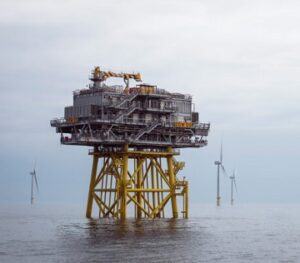 The marine mammal strandings that are taking place almost everyday along the US east coast are the most visible consequence of the Biden administration’s reckless disregard of all environmental safeguards that had been carefully crafted since the environmental movement started in the 1960’s. Left by the wayside in their rush to meet artificially imposed production deadlines, are the Clean Water Act, Endangered Species Act, [ESA] and the National Environmental Policy Act, [NEPA]. A rouge and abhorrent federal Agency, BOEM, [Bureau of Ocean Energy Management], under the Interior Department, has highjacked Fishery Management and protection of our marine resources from the National Marine Fishery Service, [part of NOAA, and under control of the Commerce Department] and has thumbed their nose at any restraints that are legally required under both the ESA and NEPA. Embarrassingly, the cowards at the National Marine Fishery Service have stood by and watched as
The marine mammal strandings that are taking place almost everyday along the US east coast are the most visible consequence of the Biden administration’s reckless disregard of all environmental safeguards that had been carefully crafted since the environmental movement started in the 1960’s. Left by the wayside in their rush to meet artificially imposed production deadlines, are the Clean Water Act, Endangered Species Act, [ESA] and the National Environmental Policy Act, [NEPA]. A rouge and abhorrent federal Agency, BOEM, [Bureau of Ocean Energy Management], under the Interior Department, has highjacked Fishery Management and protection of our marine resources from the National Marine Fishery Service, [part of NOAA, and under control of the Commerce Department] and has thumbed their nose at any restraints that are legally required under both the ESA and NEPA. Embarrassingly, the cowards at the National Marine Fishery Service have stood by and watched as
research vessels have been performing geologic surveys with high powered Sonar, and Seismic devises before they had their incidental take permits issued. They have also authorized over 100,000 level B takes of marine mammals, and that’s just for a few projects, as they fully expect the offshore wind factories to cause the extinction of the critically endangered Northern Right Whale. Just ask Sean Hayes, from the NMFS protected species department, whose observations were ignored by BOEM, hence an ESA violation.
Despite government and wind supporters denying any proof that could link the unseen before amount of strandings to the coincidental use of geological sonar and seismic research, [usually only of a type performed by oil companies] in the near vicinity of the strandings, the evidence mounts. This week, two Humpback Whales washed ashore in Martha’s Vineyard, coincidentally only a few days after Piledriving started at a nearby wind site. Piledriving of the turbine stanchions creates a 260 DBs level sound, that no amount of “Bubble Curtains” can contain. It is deadly. A few weeks before that beaches on the south shore of Nantucket had a carpet of dead crabs, clams, and other benthic organisms that are susceptible to seismic testing, which coincidentally was taking place nearby, [“sparkers” and sub- bottom profilers are seismic equipment]. The relationship of marine animal deaths while unsafe level industrial noises are being produced in the same vicinity are too numerous to ignore, worldwide. So, stop denying them.
Marine Noise pollution has been an increasing problem on an Oceanic level since the invention of the steam engine. Most of that noise increase was caused by increased vessel traffic, by increasingly larger ships, [and faster, so they could hit more Whales], but as the 20th century dawned, War became the largest noise increase ever. Torpedoes, depth charges, 16 inch shells exploding, and finally the creation of Sonar. There has never been an accounting of how many marine mammals died from the 20th century wars, but the amount would be staggering. Just as staggering would be the amount of marine mammals killed by the military, [that’s all countries] in training exercises, or testing of weapons, like at Bikini Atoll.
In the 1960’s as the Soviet factory fishing fleet was in the process of catching everything in the ocean as close as 12 miles off the US coast, our fisheries began to suffer from a silent deadly killer within, open cooling system nuclear power plants. By the mid 1970’s there were around 40 operational nuclear power plants on the US east coast all using estuarine or ocean water to cool the reactor system. How deadly are they? The following is from an NRDC issue brief, April 2014, “Power plant Cooling and Associated impacts”; “As water is being drawn into a cooling system, full-grown fish and other aquatic life are smashed and trapped against screens at the opening of an intake structure. This is referred to as impingement. In addition, early-life-stage fish, eggs, and larvae are often sucked into the cooling system, where they are harmed by heat, pressure, mechanical stress, and/or chemicals used to clean the cooling system before being dumped back into a water body. This is referred to as entrainment.”
Now it gets interesting, NRDC continues; “Throughout the country, the toll on fisheries by power plants rivals or even exceeds that of the fishing industry.
* The Salem Nuclear Plant in New Jersey kills an estimated 1.12 million weakfish and 842 million bay anchovies per year-four times more than are caught by commercial fishermen.”
* The 16 California power plants using once through cooling systems have the ability to suck in around 14.5 billion gallons of seawater every day. Annually they kill an estimated 2.4 million fish and 17.5 billion larvae. For the 12 coastal power plants in the Southern California Bight, impingement of recreational fish species accounts for 8 percent to 30 percent of the number of fish caught in the Bight.
* Cumulatively, the five power plants on New York’s Hudson River have killed as many as 79 percent of all the fish born in a single species in a single year.
* In 2008, the Bayshore coal power plant in Ohio killed more than 60 million adult fish and more than 2.5 billion fish eggs and larvae. Three of the plants four units shut down in September 2012, thereby reducing the number of fish kills since then; nevertheless, the EPA admitted that the plant likely impinged and entrained more fish than all of Ohio’s other cooling water intakes combined.”
There can be no scientific debate about the massive aquatic mortality caused by “Once-through” cooling systems that draw upon estuarine or ocean water for cooling purposes. That is why new power plants are now prohibited from using them. Apparently, nobody gave the folks at BOEM the memo. In an official BOEM document written by Pamela Middleton and Bethany Barnhart called, “Supporting National Environmental Policy Act Documentation for Offshore Wind Energy Development related to High Voltage Direct Current Cooling Systems” the authors contend that the only feasible cooling system for a HVDC Substation is a once through, or open system. The kind that is not allowed for new power plant construction, because of its devastating effects on aquatic life. This embarrassing Official BOEM document concerning the effects of offshore wind substations admits it knows nothing about how many substations are planned, how big, and where they will be. NEPA concerns such as environmental and economic costs to other industries are totally ignored within the enormous expanse of information contained within the 4 ½ pages of actual text. Up until the Green new deal a NEPA supporting document would be hundreds, and even thousands of pages long, detailing all aspects of a proposed project.
From page #1 of the BOEM NEPA document; “Converting high voltage electricity from AC to DC for long range bulk transmission from offshore wind farms reduces losses of power experienced on AC transmission lines and becomes cost effective within 37 to 60 miles from shore [BVGassociates, 2019;ICF, 2018]. When electricity is generated offshore, it is converted from AC to DC for transmission from the offshore windfarm, then converted back to AC onshore for distribution to consumers. The offshore conversion from AC to DC is accomplished through an HVDC system located in the wind farm. The HVDC system converts AC to DC, creating a byproduct of heat in the process. For the system to operate continually, the portion of the conversion equipment that emits heat, called the “thyristor,” must be cooled.” Keep in mind that this conversion process means that AC is converted to DC in an offshore substation, then DC is transmitted under the seabed to shore where it is converted back to an AC land-based substation. Which generates more heat into the atmosphere, and no mention is made of what cooling system will be used for the onshore substations, or where they will be located.
How big is a substation? From page 2, “Presently HVDC system structures for an offshore wind farm range from about 200 to 400 feet long, 140 to 350 feet wide, 80 to 300 feet high, and weigh several thousand tons [Mayflower Wind Energy, LLC, 2021; Sunrise Wind, LLC, 2021; Siemens, 2015; Kirchgeorg, et al, 2018] These structures are likely to get larger as offshore wind farms grow and move further offshore.” These structures are massive already, and may get bigger. What does that mean? How big is big? If an offshore site has 80 turbines how many substations are needed? One, two, ten? There is no mention in the document. How are they secured to the bottom? How many gallons of sea water would be circulated through a once through system per hour? How many degrees hotter would that dumped water be than it was before being used? What species of fish will be impinged and what is the economic effect on the fishing industry? None of these basic NEPA information requirements are included. Instead, we get this in regard to impingement and entrainment; “Most filtration systems backflush filters to allow for continuous use, so the collected filtrates will eventually return to the ecosystem; however, larval species will be lost and will not grow to maturity.” {Woke-speak for they will be killed]. “The number of larval fish and invertebrates lost in the process is difficult to measure. Losses of larval food sources for other species is notable, in addition to the larval species that do not survive to maturity. It is unclear how many marine species do not mature to reproduce and provide fish and shellfish for human and animal consumption.” They might as well have added, “and we don’t care.”
The whole point of these wind turbines is to stop Global warming, yet a new study from Harvard concluded that warming continental temperatures could ensue from widespread wind energy, primarilythrough enhancement of low-level atmospheric mixing and interruption of radiative nighttime cooling. This net localized effect was quantified in 10 other studies. In regard to the “warm” water discharged from an offshore substation, the BOEM document has this to say, “Temperatures of the discharge water have not been documented for the proposed wind farms on the OCS to date. The warmer outflow from HVDC is generally accepted as a minimal effect that will be absorbed and transition to ambient temperatures over time.” “Given the single point outlet within the large mass of surrounding ocean, effects from the warm water are likely to be extremely minimal. Similar conclusions have been made for any chemicals added to prevent growth within the seawater system.” Those chemicals include sodium hypochlorite, used to kill any tiny marine life that might dare to attempt to grow within the system, at least it is noted that sodium hypochlorite would be used in the 10-200 parts per million, but it doesn’t say per million of what, assumed to be ocean water. So, the water will be heated substantially but to an unknown degree, while at the same time an anti-lifeacide chemical will be introduced to the marine environment, but don’t worry the ocean can absorb it all. Just like the good old days.
I think this BOEM NEPA document perfectly presents the Biden regime’s contempt for the environmental laws that have been put in place over the last half century to protect our wildlife and environment. This paper has a disclaimer inside stating the views and conclusions contained in this document are those of the authors and should not be interpreted as representing the opinions or policies of the US government, nor does mention of trade names and commercial products constitute
endorsement or recommendation for use. BOEM should disclaim the whole document, pitiful as it is. I believe that this document was submitted in all its inadequacies on purpose to legally meet NEPA requirements concerning project submission timing, knowing that by the time any legal recourse could be taken, the issue would be moot. They are going full steam ahead and no stupid precautionary principle, or environmental law will stop them. The NRDC has provided us with the information proving how deadly “once through” cooling systems are, why are they even being proposed for usage? It is because they are cheaper, ignoring the environmental disaster they are creating, we must save the world. In reality though, it’s all about the Benjamin’s.

































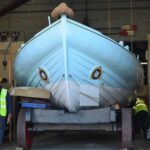
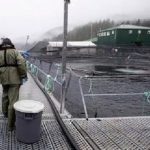

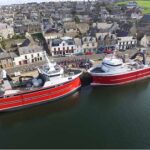
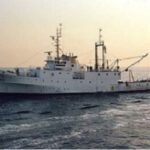

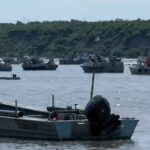




[…] *** Offshore Wind Electrical Substations; The Secret, Silent Killers […]
Hurricanes thrive on warmer waters.
[…] construction starts. Jim Lovgren writing at FisheryNation.com describes OSW environmental issues: Offshore Wind Electrical Substations; The Secret, Silent Killers that substantiate my […]